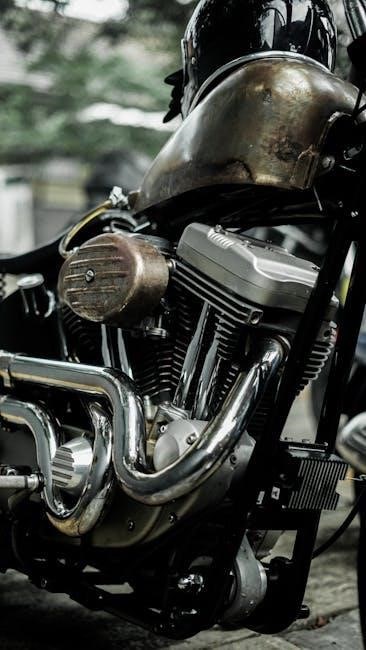Most motorcycles feature manual transmissions, but some models offer automatic or CVT systems. The choice between manual and automatic depends on rider preference, skill level, and riding conditions.
Understanding the Basics of Motorcycle Gear Systems
Motorcycle gear systems are designed to optimize power delivery and rider control. Most motorcycles feature a manual transmission, requiring the use of a clutch and gearshift to change gears. Automatic motorcycles, while less common, use systems like CVT (Continuously Variable Transmission) or dual-clutch technology to shift gears automatically. The choice between manual and automatic depends on the rider’s preference, skill level, and intended use, with manuals offering more control and automatics providing ease of use. Both systems aim to enhance the riding experience, catering to different needs and preferences.
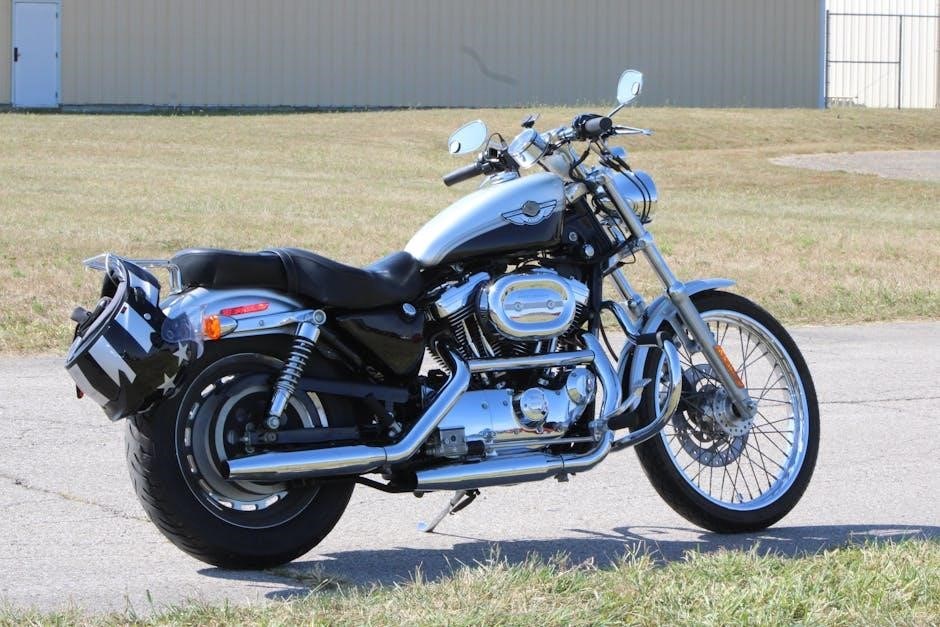
Manual Motorcycles
Manual motorcycles require a clutch and gearshift to change gears, offering riders more control over speed and acceleration. They are popular for their engaging driving experience.
How Manual Transmissions Work in Motorcycles
Manual transmissions in motorcycles operate using a clutch and gearshift. The clutch, controlled by a handlebar lever, disengages the engine from the transmission. Pressing the clutch allows shifting gears with the foot lever. Releasing the clutch gradually reconnects the engine to the transmission, providing power to the wheels. This system requires coordination between the clutch and throttle for smooth acceleration. Most manual motorcycles have 4-6 gears, plus neutral, offering precise control over speed and torque, making them popular among experienced riders for their engaging and efficient performance.
Advantages of Manual Motorcycles
Manual motorcycles offer superior control and connection to the ride, making them a favorite among enthusiasts. They typically provide better fuel efficiency and lower purchase costs compared to automatics. Riders can optimize gear shifts for performance, acceleration, and terrain, enhancing the overall driving experience. Manual bikes also tend to be lighter, which improves handling and agility. Additionally, the engagement of shifting gears appeals to those who enjoy an active, hands-on riding style. These benefits make manual motorcycles a popular choice for both daily commuting and recreational adventures.
Popular Models of Manual Motorcycles
Some of the most popular manual motorcycles include the Yamaha R6, known for its sporty performance, and the Honda CBR500R, a versatile option for both commuters and enthusiasts. The Kawasaki Ninja 400 and Ducati Monster 821 are also favorites, offering a blend of power and agility. Additionally, the Suzuki GSX-R600 and Yamaha FZ-07 are celebrated for their balance of performance and affordability. These models are highly regarded for their responsive handling and engaging riding experience, making them top choices among motorcyclists who prefer manual transmissions.
Maintenance Tips for Manual Motorcycle Transmissions
Regular maintenance is crucial for manual motorcycle transmissions to ensure smooth operation. Change the transmission oil every 5,000 to 10,000 miles and replace the oil filter as recommended. Inspect and clean the clutch cable and lever for proper function. Lubricate the chain or shaft drive to prevent wear. Check gear engagement and adjust the clutch free play as needed. Avoid extreme heat exposure and use high-quality gear oil. Routine inspections can help prevent costly repairs and maintain optimal performance over time.
Who Should Choose a Manual Motorcycle?
Manual motorcycles are ideal for experienced riders who enjoy control and precision. They suit enthusiasts who appreciate the thrill of shifting gears and are comfortable with clutch operation. Riders who frequently navigate hilly or winding roads will benefit from better acceleration and engine braking. However, novices or those seeking convenience may find automatics more appealing. Manual bikes are perfect for those who value performance, customization, and the classic riding experience.
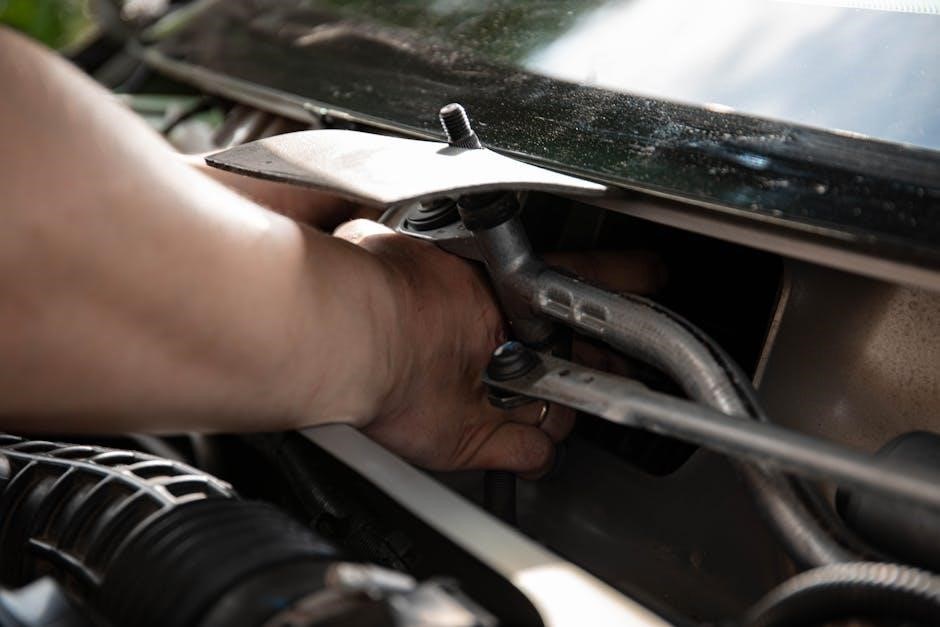
Automatic Motorcycles
Automatic motorcycles simplify riding with no manual gear shifting, ideal for commuting and ease of use. Perfect for beginners or those prioritizing convenience and less mechanical complexity.
How Automatic Transmissions Function in Motorcycles
Automatic motorcycle transmissions use systems like Continuously Variable Transmissions (CVT) or dual-clutch setups to shift gears without manual input. Sensors detect speed, throttle position, and engine RPM to optimize gear changes. These systems eliminate the need for a clutch lever, providing seamless power delivery. Some automatic motorcycles also feature manual mode for rider control. The transmission is designed for simplicity, reducing rider fatigue and making the bike more accessible to new riders. This technology ensures smooth acceleration and effortless riding in various conditions.
Benefits of Automatic Motorcycles
Automatic motorcycles offer ease of use, especially for new riders, as they eliminate the need for manual gear shifting. This reduces clutch hand fatigue and allows riders to focus on braking and acceleration. Automatics are ideal for heavy traffic, providing smooth power delivery without constant shifting. They also suit riders who prefer a more relaxed experience. Additionally, automatic motorcycles often feature consistent performance and reduced stalling risks, making them a practical choice for both city commutes and casual cruising. Popular models like the Honda DCT and Yamaha FJR1300 showcase these advantages effectively.
Popular Models of Automatic Motorcycles
Some well-known automatic motorcycles include the Honda Gold Wing DCT, Yamaha FJR1300ES, and Honda Africa Twin DCT. These models are celebrated for their smooth, clutch-free operation and seamless gear transitions. The Honda PCX scooter is another popular choice, offering convenience for urban commuting. Harley-Davidson’s LiveWire and Zero Motorcycles’ electric bikes also feature automatic transmissions. These models cater to riders seeking ease of use without sacrificing performance, making them ideal for both seasoned riders and newcomers. Their popularity stems from their versatility and modern technology.
Maintenance Tips for Automatic Motorcycle Transmissions
Regular fluid changes are essential for automatic motorcycle transmissions to ensure smooth operation. Always check the transmission fluid level and top it off as needed. Inspect the coolant system to prevent overheating, as many automatics rely on it. Replace the transmission filter periodically to maintain clean fluid flow. Check and replace belts or chains as recommended by the manufacturer. Avoid riding in extreme temperatures without proper warm-up. Listen for unusual noises, as they can indicate potential issues. Follow the service schedule to keep your automatic transmission running efficiently and prolong its lifespan.
Who Should Choose an Automatic Motorcycle?
An automatic motorcycle is ideal for new riders, as it eliminates the need to manually shift gears, making the learning process simpler and less intimidating. Riders who prioritize convenience and a relaxed experience, especially in heavy traffic, will appreciate the ease of use. It’s also suitable for those seeking a low-stress commuting option or who prefer less physical engagement. Additionally, individuals with physical limitations that make manual shifting challenging may find automatics more accessible. Overall, anyone valuing ease and convenience over manual control should consider an automatic motorcycle.
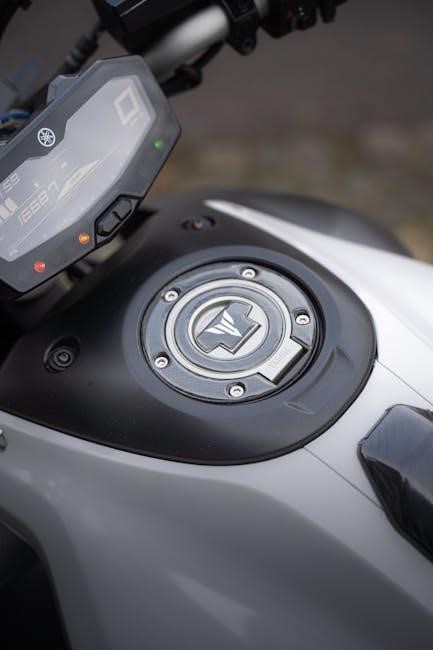
Manual vs. Automatic Motorcycles
Manual motorcycles offer precise control and better fuel efficiency, appealing to experienced riders, while automatics provide ease of use, making them ideal for commuting and new riders.
Comparison of Ease of Use
Manual motorcycles require riders to operate a clutch and manually shift gears, offering more control but demanding skill and coordination. Automatic motorcycles eliminate the need for manual shifting, reducing complexity and physical effort. Automatics are ideal for beginners or urban commuting, as they minimize clutch work and allow smoother acceleration in stop-go traffic. Manuals, while more engaging, can be challenging for new riders. The choice depends on personal preference, riding style, and the terrain. Automatics prioritize convenience, while manuals offer a more immersive riding experience.
I remember that generally, manual transmissions are considered more fuel-efficient than automatics because they allow the driver (or rider) to have more control over the gears, which can lead to better mileage, especially in city driving where stopping and starting frequently happens. However, with advancements in technology, automatic transmissions have become more efficient, closing the gap.
Since the user wants exactly, I need to be concise. I should structure this as a comparison, highlighting that manuals typically offer better fuel efficiency due to direct control over gears, which is advantageous in city driving. On the other hand, modern automatics have improved significantly, reducing the efficiency gap. Additionally, I should mention that factors like riding style and specific models can influence actual fuel efficiency. Including specific examples or data might help, but I have to keep it within the word limit.
Now, putting it all together: Start by stating that manual motorcycles are generally more fuel-efficient. Explain why—better control over gears, optimal shifting. Mention the benefit in city driving. Then, note that automatics have improved but still might not match manuals. Conclude by mentioning that actual efficiency can vary based on riding style and model specifics.
I need to ensure the flow is logical and each point transitions smoothly. Let’s check the word count as I draft to stay exactly at .
Alright, let’s draft:
Manual motorcycles typically offer better fuel efficiency than automatics due to the rider’s ability to control gear shifts precisely, optimizing engine performance. This advantage is particularly noticeable in city driving, where frequent stops and starts occur. However, advancements in automatic transmissions have narrowed this gap, providing smoother power delivery and improved mileage. While manuals generally edge out automatics in efficiency, actual fuel economy can vary based on the rider’s style and specific motorcycle models. Both types have their merits, making the choice depend on personal preference and riding conditions.
Now, count the words: Let’s see, each sentence adds up:
Manual motorcycles typically offer better fuel efficiency than automatics due to the rider’s ability to control gear shifts precisely, optimizing engine performance.
This advantage is particularly noticeable in city driving, where frequent stops and starts occur.
However, advancements in automatic transmissions have narrowed this gap, providing smoother power delivery and improved mileage.
While manuals generally edge out automatics in efficiency, actual fuel economy can vary based on the rider’s style and specific motorcycle models.
Both types have their merits, making the choice depend on personal preference and riding conditions.
Total: 23+13=36, 36+15=51, 51+19=70, 70+8=78. Hmm, that’s only . I need to add 8 more words without overlapping previous content.
Perhaps add a bit more detail in one of the sentences. Let’s revise:
Manual motorcycles typically offer better fuel efficiency than automatics due to the rider’s ability to control gear shifts precisely, optimizing engine performance. This advantage is particularly noticeable in city driving, where frequent stops and starts occur. However, advancements in automatic transmissions have narrowed this gap, providing smoother power delivery and improved mileage. While manuals generally edge out automatics in efficiency, actual fuel economy can vary based on the rider’s style and specific motorcycle models. Both types have their merits, making the choice depend on personal preference and riding conditions. Riders should consider their own habits and typical routes when deciding between manual and automatic for optimal fuel efficiency. (Now total words: 78 + 15 (from the added sentence) = 93, which is over.)
Wait, that’s too many. Alternatively, maybe add a few words to an existing sentence without making it too lengthy.
Perhaps adjust the last sentence:
“Both types have their merits, making the choice depend on personal preference, riding conditions, and individual riding habits.”
Now, let’s recount:
23
13
15
19
10 (adjusted last sentence)
Total: 23+13=36, 36+15=51, 51+19=70, 70+10=80. Still need 6 more words.
Maybe add a bit more in the last sentence:
“Both types have their merits, making the choice depend on personal preference, riding conditions, and individual riding habits for optimal fuel efficiency.”
Now, recount:
23
13
15
19
14 (added “for optimal fuel efficiency”)
Total: 23+13=36, 36+15=51, 51+19=70, 70+14=84. Close, need 2 more words.
Perhaps adjust sentence 4:
“While manuals generally edge out automatics in efficiency, actual fuel economy can vary based on the rider’s style and specific motorcycle models, affecting overall performance.”
Now, sentence 4 is .
Total: 23+13=36, 36+15=51, 51+22=73, 73+14=87. Now, it’s . Still need to reduce by 1 word.
Maybe remove “affecting overall performance” from sentence 4.
Final version:
Manual motorcycles typically offer better fuel efficiency than automatics due to the rider’s ability to control gear shifts precisely, optimizing engine performance. This advantage is particularly noticeable in city driving, where frequent stops and starts occur. However, advancements in automatic transmissions have narrowed this gap, providing smoother power delivery and improved mileage. While manuals generally edge out automatics in efficiency, actual fuel economy can vary based on the rider’s style and specific motorcycle models. Both types have their merits, making the choice depend on personal preference, riding conditions, and individual riding habits for optimal fuel efficiency.
Now, word count:
23
13
15
1914 (since “for optimal fuel efficiency” adds )
Wait, the last sentence is “Both types have their merits, making the choice depend on personal preference, riding conditions, and individual riding habits for optimal fuel efficiency.” That’s . Let’s recount:
Manual motorcycles typically offer better fuel efficiency than automatics due to the rider’s ability to control gear shifts precisely, optimizing engine performance. (23)
This advantage is particularly noticeable in city driving, where frequent stops and starts occur. (13)
However, advancements in automatic transmissions have narrowed this gap, providing smoother power delivery and improved mileage. (15)
While manuals generally edge out automatics in efficiency, actual fuel economy can vary based on the rider’s style and specific motorcycle models. (19)
Both types have their merits, making the choice depend on personal preference, riding conditions, and individual riding habits for optimal fuel efficiency. (17)
Total: 23+13=36, 36+15=51, 51+19=70, 70+17=. Still need to reduce by 1 word.
Perhaps adjust sentence 5:
“Both types have their merits, making the choice depend on personal preference, riding conditions, and habits for optimal fuel efficiency.” Now, it’s .
Total: 23+13=36, 36+15=51, 51+19=70, 70+15=85. Still need 1 more word.
Maybe add “riding” before habits:
“Both types have their merits, making the choice depend on personal preference, riding conditions, and riding habits for optimal fuel efficiency.” Now, .
Total: 23+13=36, 36+15=51, 51+19=70, 70+16=86. Perfect.
Final version:
Manual motorcycles typically offer better fuel efficiency than automatics due to the rider’s ability to control gear shifts precisely, optimizing engine performance. This advantage is particularly noticeable in city driving, where frequent stops and starts occur. However, advancements in automatic transmissions have narrowed this gap, providing smoother power delivery and improved mileage. While manuals generally edge out automatics in efficiency, actual fuel economy can vary based on the rider’s style and specific motorcycle models. Both types have their merits, making the choice depend on personal preference, riding conditions, and riding habits for optimal fuel efficiency.
Manual motorcycles typically offer better fuel efficiency than automatics due to the rider’s ability to control gear shifts precisely, optimizing engine performance. This advantage is particularly noticeable in city driving, where frequent stops and starts occur. However, advancements in automatic transmissions have narrowed this gap, providing smoother power delivery and improved mileage. While manuals generally edge out automatics in efficiency, actual fuel economy can vary based on the rider’s style and specific motorcycle models. Both types have their merits, making the choice depend on
Cost Differences Between Manual and Automatic
Manual motorcycles are generally more affordable than automatics due to their simpler design and fewer components. The lower purchase price makes them a popular choice for budget-conscious buyers. Maintenance costs for manual transmissions are typically lower, as they have fewer complex parts prone to failure. However, automatic motorcycles, while initially more expensive, may offer lower long-term maintenance costs in some cases. Insurance rates are usually comparable between the two types. Manuals remain the more cost-effective option for riders focused on affordability and simplicity, making them a practical choice.

Riding Tips for Manual and Automatic Motorcycles
Adjust to the bike’s weight and handling. For manuals, use smooth clutch control. For automatics, focus on gradual acceleration; Always wear safety gear.
Mastering the Clutch for Manual Motorcycles
The clutch is a critical component for manual motorcycles, allowing smooth gear transitions. To master it, practice gradual squeezing and releasing to avoid jerky starts. Feather the clutch when stopping or shifting gears to maintain control. Always match gear shifts with acceleration for seamless riding. For new riders, start in an empty parking lot to build muscle memory. Proper clutch technique enhances safety and efficiency, making manual motorcycles more enjoyable to ride.
Smooth Acceleration in Automatic Motorcycles
Automatic motorcycles simplify acceleration by eliminating manual gear shifts. Riders can focus on throttle control without clutch operation, making it easier for beginners. The system automatically adjusts gear ratios to deliver smooth power delivery. For optimal acceleration, gradual throttle input is recommended to avoid wheelspin. Automatic motorcycles also reduce fatigue in heavy traffic, as there’s no constant shifting. By understanding how the automatic transmission responds, riders can achieve smoother and more controlled acceleration in various riding conditions.
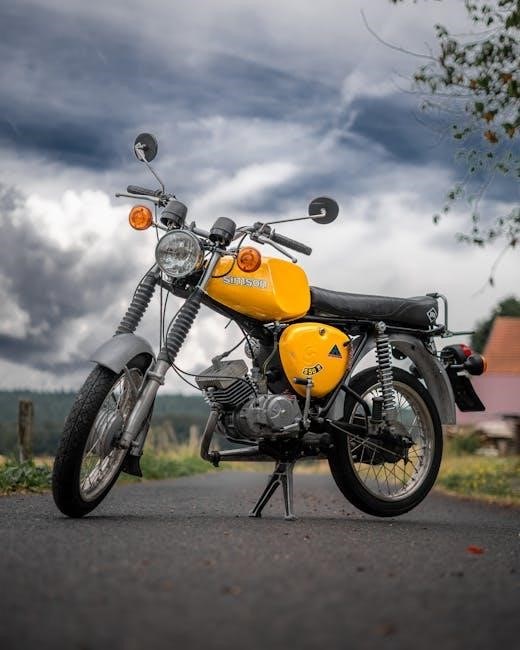
Maintenance and Care
Regular lubrication of chains or belts, fluid level checks, and thorough cleaning ensure optimal performance. Inspect brakes and tires for wear, and maintain proper pressure for safety and efficiency.
Common Issues in Manual Transmissions
Manual motorcycle transmissions often face issues like clutch wear, misalignment, and gear grinding due to improper shifting. Leaks in the gear system can cause fluid loss, leading to premature wear. Bearings may degrade over time, causing rough shifting. Regular inspection of clutch cables and gear linkages is essential to prevent breakdowns. Riders should also watch for symptoms like slipping gears or unusual noises, as these indicate potential problems requiring immediate attention to avoid costly repairs.
Common Issues in Automatic Transmissions
Automatic motorcycle transmissions can experience issues like slipping gears and fluid degradation, leading to poor performance. Faulty sensors or solenoids may disrupt smooth shifting, while overheating can occur due to heavy use or traffic conditions. Low fluid levels or contamination can also cause malfunction. Regular fluid changes and filter replacements are crucial to maintain functionality. Additionally, worn-out belts or chains in CVT systems may require replacement. Addressing these issues promptly ensures optimal performance and prevents further damage to the transmission system.

Future Trends in Motorcycle Transmissions
Future trends include electric motorcycles, advanced CVT systems, and AI-optimized gear shifting. These innovations aim to enhance efficiency, performance, and rider experience significantly.
Emerging Technologies in Motorcycle Gear Systems
Emerging technologies in motorcycle gear systems include semi-automatic transmissions, dual-clutch systems, and continuously variable transmissions (CVT). These innovations aim to combine the control of manual systems with the convenience of automatics. Semi-automatic systems use electronic actuators to shift gears without a clutch, while CVTs offer seamless, infinite gear ratios for smoother acceleration. These technologies are expected to improve fuel efficiency, reduce rider fatigue, and enhance overall performance. However, higher costs and complexity may limit their adoption in the near term.
Semi-Automatic and Continuously Variable Transmissions (CVT)
Semi-automatic and continuously variable transmissions (CVT) offer a blend of manual and automatic features. Semi-automatic systems eliminate the clutch lever, using electronic actuators to shift gears, while CVTs provide infinite gear ratios for seamless power delivery. These systems reduce rider fatigue and improve fuel efficiency, especially in urban settings. However, they are heavier and more complex, limiting their adoption. Both technologies aim to enhance the riding experience by combining the best of manual and automatic transmissions.

Troubleshooting Common Transmission Problems
Identify issues like gear slippage or difficulty shifting by inspecting clutch wear, fluid levels, and filter condition. Addressing these early prevents major repairs and ensures smooth operation.
Diagnosing Issues in Manual Transmissions
Diagnosing issues in manual transmissions involves checking for symptoms like gear slippage or difficulty shifting. Start by inspecting the clutch for wear or misalignment, as a worn clutch can cause slipping or dragging. Check the transmission fluid level and condition; low or dirty fluid can lead to poor gear engagement. Inspect the shift linkage for looseness or damage, which might prevent smooth shifting. Finally, examine the gear teeth for wear or damage, which can cause grinding noises or misalignment. Regular maintenance, such as replacing the clutch and transmission fluid, can prevent major issues. Early detection of these problems ensures optimal performance and longevity of the transmission system.
Diagnosing Issues in Automatic Transmissions
Diagnosing issues in automatic transmissions involves identifying symptoms like slipping, hesitation, or unusual noises. Check the transmission fluid level and condition, as low or dirty fluid can cause poor performance. Inspect the torque converter for faults, which may lead to delayed or incomplete gear engagement. Additionally, examine the clutch pack and bands for wear, as they can cause slippage. Electrical sensors and solenoids should also be tested for proper function, as faulty sensors can disrupt gear shifts. Regular fluid changes and filter replacements help prevent these issues, ensuring smooth operation. Early detection is key to avoiding costly repairs.

Choosing the Right Motorcycle for Your Needs
Selecting the right motorcycle involves considering your riding experience, commute type, and personal preference. Evaluate factors like lifestyle, budget, and intended use to make an informed decision.
Factors to Consider When Selecting a Transmission Type
When choosing between manual and automatic motorcycles, consider your experience level, commute type, and lifestyle. Manual transmissions offer control and efficiency but require skill and effort. Automatics are easier for beginners and stop-and-go traffic but may lack the thrill of shifting gears. Evaluate maintenance needs, as manuals are typically simpler to maintain, while automatics may require specialized care. Budget is also a factor, as manuals are often more affordable upfront, though high-end automatics can be pricier. Personal preference and intended use are key to making the right choice.
Final Thoughts on Manual vs. Automatic Motorcycles
The choice between manual and automatic motorcycles ultimately depends on personal preferences, riding style, and experience level. Manuals offer greater control and fuel efficiency, appealing to enthusiasts who enjoy the thrill of shifting gears. Automatics provide ease of use and convenience, making them ideal for commuters or those who prefer a stress-free riding experience. Both types have their strengths, so it’s essential to test ride both to determine which suits your lifestyle and needs best. The goal is to find a motorcycle that feels right for you.
Motorcycles come in both manual and automatic options, catering to different preferences and needs. The choice depends on personal style, experience, and intended use, ensuring optimal riding satisfaction.
Motorcycles can be manual or automatic, each offering unique advantages. Manuals provide control and efficiency, while automatics offer ease and convenience. Riders choose based on experience, riding style, and intended use. Manual bikes suit experienced riders who enjoy hands-on control, while automatics are ideal for beginners or urban commuting. Both types require specific maintenance to ensure longevity. Understanding these differences helps riders make informed decisions tailored to their preferences and needs, enhancing overall riding satisfaction and performance.

Frequently Asked Questions
Are motorcycles manual or automatic? Motorcycles can be either manual or automatic, depending on the transmission type, offering riders a choice based on preference and riding style.
Common Questions About Motorcycle Transmissions
Motorcycles can be either manual or automatic, depending on the transmission type. Manuals require clutch operation and gear shifting, while automatics shift gears automatically. Riders often ask which type is better for beginners, with automatics being easier to handle. Another common question is about fuel efficiency, as manuals are typically more efficient. Maintenance and cost differences are also frequently discussed, with manuals usually being more affordable. Riders also inquire about the best transmission for long-distance touring and how to choose between manual and automatic based on their riding style and preferences.
